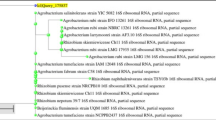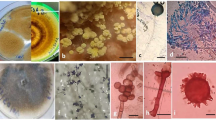Summary
Pseudomonas fluorescens strain CHA0 produces hydrogen cyanide (HCN), a secondary metabolite that accounts largely for the biocontrol ability of this strain. In this study, we examined the role of HCN production by CHA0 as an antagonistic factor that contributes to biocontrol of Meloidogyne javanica, the root-knot nematode, in situ. Culture filtrate of CHA0, resulting from 1/10-strength nutrient broth yeast extract medium amended with glycine, inhibited egg hatch and caused mortality of M. javanica juveniles in vitro. The bacterium cultured under high oxygen-tension conditions exhibited better inhibitory effects towards nematodes, compared to its cultivation under excess oxygen situation. Growth medium amended with 0.50 or 1.0 mM FeEDDHA further improved hatch inhibition and nematicidal activity of the strain CHA0. Strain CHA77, an HCN-negative mutant, failed to exert such toxic effects, and in this strain, antinematode activity was not influenced by culture conditions. Exogenous cyanide also inhibited egg hatch and caused mortality of M. javanica juveniles in vitro. Strains CHA0 or CHA77 applied in unsterilized sandy-loam soil as drench, caused marked suppression of root-knot disease development incited by M. javanica in tomato seedlings. However, efficacy of CHA77 was noticeably lower compared to its wild type counterpart CHA0. An increased bioavailability of iron following EDTA application in soil substantially improved nematode biocontrol potential of CHA0 but not that of CHA77. Soil infestation with M. javanica eggs resulted in significantly lower nematode population densities and root-knot disease compared to the juveniles used as root-knot disease-inducing agents. Strain CHA0 significantly suppressed nematode populations and inhibited galling in tomato roots grown in soil inoculated with eggs or juveniles and treated with or without EDTA. Strain CHA0 exhibited greater biocontrol potential in soil inoculated with eggs and treated with EDTA. To demonstrate that HCN synthesis by the strain CHA0 acts as the inducing agent of systemic resistance in tomato, efficacy of the strain CHA0 was compared with CHA77 in a split root trial. The split-root experiment, guaranteeing a spatial separation of the inducing agent and the challenging pathogen, showed that HCN production by CHA0 is not crucial in the induction of systemic resistance in tomato against M. javanica, because the HCN-negative-mutant CHA77 induced the same level of resistance as the wild type but exogenous cyanide in the form of KCN failed to trigger the resistance reaction. In the root section where both nematode and the bacterium were present, strain CHA0 reduced nematode penetration to a greater extent than CHA77, suggesting that for effective control of M. javanica, a direct contact between HCN-producing CHA0 and the nematode is essential.
Similar content being viewed by others
References
Askeland R.A., Morrison S.M., 1983. Cyanide production by Pseudomonas fluorescens and Pseudomonas aeruginosa Applied and Environmental Microbiology 45: 1802–1807
Bakker P.A.H.M., Bakker A.W., Marugg I.D., Weisbeek P.J., Schippers B., 1987. Bioassay for studying the role of siderophores in potato growth stimulation by Pseudomonas spp. in short potato rotations Soil Biology and Biochemistry 19: 451–457
Blumer C., Haas D., 2000. Mechanism, regulation, and ecological role of bacterial cyanide biosynthesis Archives of Microbiology 173: 170–177
Buyer J.S., Leong J., 1986 Iron transport-mediated antagonism between plant growth-promoting and plant-deleterious Pseudomonas strains Journal of Biological Chemistry 261: 791–794
Castric P.A., 1975. Hydrogen cyanide, a secondary metabolite of Pseudomonas aeruginosa Canadian Journal of Microbiology 21: 613–618
Castric P.A., 1977 Glycine metabolism by Pseudomonas aeruginosa: hydrogen cyanide biosynthesis Journal of Bacteriology 130: 826–831
Cayrol J.C., Djian C., Pijarowiski L., 1989. Study on the nematicidal properties of the culture filtrate of the nematophagous fungus Paecilomyces lilacinus Revue de Nematologie 12: 331–336
Cunningham L., Pitt M., Williams H.D., 1997 The cioAB genes from Pseudomonas aeruginosa code for a novel cyanide-insensitive terminal oxidase related to the cytochrome bd quinol oxidases Molecular Microbiology 24: 579–591
Demeyer G., Höfte M., 1997 Salicylic acid produced by the rhizobacterium Pseudomonas aeruginosa 7NSK2 induces resistance to leaf infection by Botrytis cinerea on bean Phytopathology 87: 588–593
Flaishman M.A., Eyal Z., Zilberstein A., Voisard C., Haas D., 1996. Suppression of Septoria tritici blotch and leaf rust of wheat by recombinant cyanide-producing strains of Pseudomonas putida Molecular Plant-Microbe Interactions 9: 642–645
Fravel D.R., 1988. Role of antibiosis in the biocontrol of plant diseases Annual Review of Phytopathology 26: 75–91
Gallagher L.A., Manoil C., 2001 Pseudomonas aeruginosa PAO1 kills Caenorhabditis elegans by cyanide poisoning Journal of Bacteriology 183: 6207–6214
Højberg, O., Schnider, U., Winteler, H.V., Sørensen, J. & Hass, D. 1999 Oxygen sensing reporter strain of Pseudomonas fluorescens for monitoring the distribution of low-oxygen habitats in soil. Applied and Environmental Microbiology 65, 4085–4093
Keel C., Voisard C., Berling C.-H., Kahr G., Défago G., 1989 Iron sufficiency, a prerequisite for suppression of tobacco black root rot in Pseudomonas fluorescens strain CHA0 under gnotobiotic conditions Phytopathology 79: 584–589
King E.O., Ward M.K., Raney D.E., 1954 Two simple media for the demonstration of pyocyanine and fluorescein Journal of Laboratory and Clinical Medicine 44: 301–307
Kloepper J.W., Leong J., Teintze M., Schroth M.N., 1980 Enhanced plant growth by siderophores produced by plant growth-promoting rhizobacteria Nature (London) 286: 885–886
Kloepper J.W., 1993. Plant growth-promoting rhizobacteria as biological control agents In: Metting B., (Ed.). Soil Microbial Technologies Marcel Dekker, Inc. New York pp. 255–274 ISBN 0824787374
Kloepper J.W., Beauchamp C.J., 1992. A review of issues related to measuring colonization of plant roots by bacteria Canadian Journal of Microbiology 38: 1219–1232
Knowles C.J., Bunch A.W., 1986. Microbial cyanide metabolism Advances in Microbial Physiology 27: 73–111
Laville J., Blumer C., Von Schroetter C., Gaia V., Défago G., Keel C., Haas D., 1998. Characterization of the hcnABC gene cluster encoding hydrogen cyanide ad anaerobic regulation by ANR in the strictly aerobic biocontrol agent Pseudomonas fluorescens CHA0 Applied and Environmental Microbiology 180: 3187–3196
Laville J., Voisard C., Keel C., Maurhofer M., Défago G., Haas D., 1992. Global control in Pseudomonas fluorescens mediating antibiotic synthesis and suppression of black root rot of tobacco Proceedings of National Academy of Sciences, USA 89: 1562–1566
Leeman M., Den Ouden F.M., Van Pelt J.A., Dirkx F.P.M., Steijl H., Bakker P.A.H.M., Schippers B., 1996. Iron availability affects induction of systemic resistance to Fusarium wilt of raddish by Pseudomonas fluorescens Phytopathology 86: 149–155
Sacherer P., Défago G., Haas D., 1994. Extracellular protease and phospholipase C are controlled by the global regulatory gene gacA in the biocontrol strain Pseudomonas fluorescens CHA0 FEMS Microbiology Letters 116: 155–160
Scher F.M., Baker R., 1982. Effect of Pseudomonas putida and a synthetic iron chelator on induction of soil suppressiveness to Fusarium wilt pathogens Phytopathology 72: 1567–1573
Shen Z.G., Liu Y.L., Chen H.M., 1998. Effects of chelators EDTA and DTPA on the uptake of zinc, copper, manganese and iron by hyperaccumulator Thlaspi caerulescens Acta Phytophysiologica Sinica 24: 340–346
Siddiqui I.A., Shaukat S.S., 2002a Mixtures of plant disease suppressive bacteria enhance biological control of multiple tomato pathogens Biology and Fertility of Soils 36: 260–268
Siddiqui I.A., Shaukat S.S., 2002b Zinc and glycerol enhance the production of nematicidal compounds in vitro and improve the biocontrol of Meloidogyne javanica in tomato by fluorescent pseudomonads Letters in Applied Microbiology 35: 212–217
Siddiqui I.A., Shaukat S.S., 2002c Rhizobacteria-mediated induction of systemic resistance (ISR) in tomato against Meloidogyne javanica Journal of Phytopathology 150: 469–473
Siddiqui I.A., Shaukat S.S., 2003a Role of iron in rhizobacteria-mediated suppression of root-infecting fungi and root-knot nematode in tomato Nematologia Mediterranea 31: 11–14
Siddiqui I.A., Shaukat S.S., 2003b Suppression of root-knot disease by Pseudomonas fluorescens CHA0 in tomato: importance of bacterial secondary metabolite 2,4-diacetylphloroglucinol Soil Biology and Biochemistry 35: 1615–1623
Siddiqui I.A., Shaukat S.S., 2004 Systemic resistance in tomato induced by biocontrol bacteria against Meloidogyne javanica, root-knot nematode is independent of salicylic acid production Journal of Phytopathology 152: 48–54
Stutz E., Défago G., Kern H., 1986. Naturally occurring fluorescent pseudomonads involved in suppression of black root rot of tobacco Phytopathology 76: 181–185
Solomonson L.P., 1981. Cyanide as a metabolic inhibitor In: Vennesland B., Conn E.E., Knowles C.J., Westley J., Wissing F., (Eds). Cyanide in Biology Academic Press London, United Kingdom pp. 11–28 ISBN 0127169806
Van Loon L.C., Bakker P.A.H.M., Pierterse C.M.J., 1998. Systemic resistance induced by rhizosphere bacteria Annual Review of Phytopathology 36: 453–483
Van Peer R., Van Kuik A.J., Ratink H., Schippers B., 1990. Control of Fusarium wilt of carnation grown on rock wool by Pseudomonas sp. Strain WCS417r and by FeEDDHA Netherlands Journal of Plant Pathology 96: 119–132
Vining L.C., 1990 Functions of secondary metabolites Annual Review of Microbiology 44: 395–427
Voisard C., Keel C., Haas D., Défago G., 1989. Cyanide production by Pseudomonas fluorescens helps suppress black root rot of tobacco under gnotobiotic conditions EMBO Journal 8: 351–358
Voisard, C., Bull, C.T., Keel, C., Laville, J., Maurhofer, M., Schnider, U., Défago, G. & Haas D., 1994 Biocontrol of root diseases by Pseudomonas fluorescens CHA0: current concepts and experimental approaches. In: Molecular Ecology of Rhizosphere Microorganisms, eds. O’Gara, F., Dowling, D. N. & Boesten B., pp. 67–89 VCH Weinheim: ISBN 352730052X
Way J.L., 1984. Cyanide intoxication and its mechanism of antagonism Annual Review of Pharmacological Toxicology 24: 451–481
Weller D.M., 1988 Biological control of soilborne plant pathogens in the rhizosphere with bacteria Annual Review of Phytopathology 26: 379–407
Widmer T.L., Abawi G.S., 2000. Mechanism of suppression of Meloidogyne hapla and its damage by a green manure of sudan grass Plant Disease 84: 562–568
Widmer T.L., Abawi G.S., 2002. Relationship between levels of cyanide in sudan grass hybrids incorporated into soil and suppression of Meloidogyne hapla Journal of Nematology 34: 16–22
Acknowledgements
This work was supported by a grant from the Faculty of Science, University of Karachi. We thank Prof. Dieter Haas, Lausanne University, Switzerland, for the provision of Pseudomonas fluorescens strains CHA0 and CHA77. We thank Dr. Ken Evans, Rothamsted Research, U.K. for the critical review of the manuscript.
Author information
Authors and Affiliations
Corresponding author
Rights and permissions
About this article
Cite this article
Siddiqui, I.A., Shaukat, S.S., Sheikh, I.H. et al. Role of cyanide production by Pseudomonas fluorescens CHA0 in the suppression of root-knot nematode, Meloidogyne javanica in tomato. World J Microbiol Biotechnol 22, 641–650 (2006). https://doi.org/10.1007/s11274-005-9084-2
Received:
Accepted:
Published:
Issue Date:
DOI: https://doi.org/10.1007/s11274-005-9084-2




